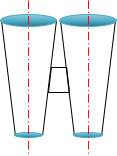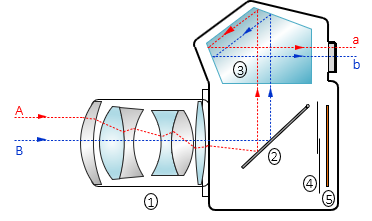6. Combining Optical Elements
a. Compound Lens
Why all the different types of thin lenses? A small single thin lens is generally not strong enough to magnify distant objects and details. A physically larger and thicker single lens would gather more light for a brighter and more detailed image, Figure H-21.
 |
| Figure H-21 Small vs Large Lenses |
It is more difficult to create a single large lens with a constant surface geometry and uniform refraction index throughout. Glass blanks are made by cooling molten glass. Uniform cooling of a large molten mass can be difficult, creating internal stresses leading to structural defects and refractive index variation.
A larger lens also requires a larger support structure, ie, a bigger camera, telescope, etc. Where space is a consideration, such as in an airplane, a more compact optical assembly is required.
A compound lens system, Figure H-22, combines different types of thin lenses.
 |
| Figure H-22 Compound Lens System |
Thin lens quality is easier to control so the resulting compound lens has fewer distortions than a thick lens. Focusing a large thick lens requires moving the entire lens generally over a long range. With a compound lens system only a few elements are moved and over a relatively short distance.
b. Optical systems
Mirrors, prisms, and lenses can be combined to create compact and powerful optical packages. A simple example is a set of binoculars, Figure H-23. Early binoculars, Figure H-23(a), were just a pair of straight telescopes mounted together with a common focusing system. Maximum size of the objective lenses was limited by the spacing between the telescopes which in turn was limited by user eye spacing. To increase magnification required longer and heavier telescopes.
 |
 |
| (a) Straight | (b) Prismatic |
| Figure H-23 Binoculars |
|
Most modern binoculars are prismatic type, so-named because they contain prisms to alter the sight paths, Figure H-23(b). A right angle prism redirects a light ray 90°. Using a pair of right angle prisms for each eye's sight line:
- spaces the objective lenses further apart so larger ones can be used. Larger lenses have greater light gathering capability so the image is brighter.
- increases focal lengths while keeping a compact case size. This facilitates higher image magnification.
Another example is the optical system of an SLR camera, Figure H-24.
 |
| (a) Pre-exposure |
 |
| (b) Exposure |
Figure H-24 Single Lens Reflex Camera |
Primary components are: (1) Compound lens, (2) First-surface mirror, (3) Pentaprism, (4) Shutter, (5) Focal plane (film or sensor array).
Light rays from the image are redirected using the mirror (2) and pentaprism (3) to the viewfinder where the camera operator sees the object in an upright position. The image size is reduced but not distorted by the optical paths. To capture the image, the mirror (2) flips up, the shutter (4) opens, and the image is recorded on the focal plane (5).